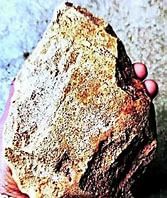UPSC Daily Current Affairs- 6th January 2024 | Current Affairs & Hindu Analysis: Daily, Weekly & Monthly PDF Download
GS-I
Paleolithic Tools Discovered in Telangana’s Mulugu District
Subject: History

Why in News?
The recent floods in Mulugu district, Telangana, have led to the discovery of Paleolithic quartzite tools, shedding new light on the region’s ancient human habitation.
- Discovery by Amateur Historians: The tools were found in a dried-up stream bed by a team led by Sriramoju Haragopal, an amateur historian.
About Paleolithic Age
| Details | |
| Timeframe | Approximately 2.6 million years ago to about 10,000 BCE. |
| Characteristics | Marked by the use of stone tools by early humans. Tools were mainly hand axes, cleavers, and choppers. |
| Major Sites |
|
| Lifestyle |
|
| Cultural Developments |
|
| Art and Symbolism |
|
| Climate and Environment |
|
| Human Species |
|
Details of the Discovery
- Location of Find: The hand axes were discovered between Gurrevula and Bhupatipuram villages in Mulugu district.
- Specific Find: Researchers found a significant stone axe measuring 15.5 cm in length, 11 cm in width, and 5.5 cm in thickness.
Context and Comparison
- Global Significance: Similar hand axes have been discovered worldwide, indicating a common tool type used by early humans for various purposes.
- Historical Context in India: The first discovery of a Paleolithic site in India was in 1863 at Attirampakkam near Madras (now Chennai), with bifacial hand-axes dating back to about 15 lakh years, known as the Madras Hand-Axe Industry or Madrasian Culture.
Historical Significance
- Paleolithic Era Tools: According to paleontologists, the stone axe dates back to the Lower Paleolithic period, approximately 30 lakh years ago.
- Tool Identification: The tools were identified based on their chipping style, material, and size, typical of Paleolithic hunter-gatherers who used heavy quartzite for large tools.
Source: The Hindu
GS-II
EB-5 Immigrant Investor Program
Subject: International Relations

Why in News?
The United States Department of State recently released data that indicates significant progress in the processing of EB-5 applications that are currently pending, especially those from Indian citizens.
About EB-5 Immigrant Investor Program:
- The EB-5 (employment-based, 5th preference), or US golden visa, provides a special road for overseas investors and their families to seek permanent residency and Green Cards in the United States.
- It is administered by the United States Citizenship and Immigration Services (USCIS).
- It was created in 1990 to stimulate the U.S. economy through job creation and capital investment by foreign investors.
- Under this program, investors (and their spouses and unmarried children under 21) are eligible to apply for lawful permanent residence (become a Green Card holder) if they:
- Make the necessary investment in a commercial enterprise in the United States, and
- Plan to create or preserve 10 permanent full-time jobs for qualified U.S. workers.
Source: Financial Express
PRITHvi VIgyan Scheme
Subject: Government Schemes

Why in News?
To enhance the understanding of the Earth and its vital signs, the Union Cabinet recently approved the “PRITHvi VIgyan (PRITHVI)” scheme.
About the PRITHVI Scheme:
- It is an initiative of the Ministry of Earth Sciences (MoES) to enhance the understanding of the Earth and its vital signs.
- This overarching initiative, with an allocation of Rs 4,797 crore for the period 2021-26, aims to significantly enhance research, modelling, and service delivery across crucial areas like weather, climate, oceans, and the polar regions.
- The Prithvi scheme integrates five existing sub-schemes:
- Atmosphere and Climate Research-Modelling Observing Systems and Services (ACROSS)
- Ocean Services, Modelling Application, Resources and Technology (O-SMART)
- Polar Science and Cryosphere Research (PACER)
- Seismology and Geosciences (SAGE)
- Research, Education, Training, and Outreach (REACHOUT).
- These programs collectively aim to enhance our understanding of the Earth's vital signs and translate scientific knowledge into practical services that benefit society, environment and economy.
- Objectives:
- One of the primary objectives of Prithvi is to augment and sustain long-term observations across the atmosphere, ocean, geosphere, cryosphere, and solid earth.
- This will enable recording and monitoring of the Earth System's vital signs and changes.
- Additionally, the scheme focuses on developing predictive models for weather, ocean, and climate hazards, as well as advancing the understanding of climate change science.
- Exploration of the polar regions and high seas is another key aspect, aiming at discovering new phenomena and resources.
- The scheme also emphasises the development of technology for the exploration and sustainable harnessing of oceanic resources for societal applications.
- Various components of the PRITHVI scheme are interdependent and are carried out in an integrated manner through the combined efforts of the concerned institutes under the MoES.
Source: Business Today
The need to examine the examination system
Subject: Governance

Why in News?
The article discusses the challenges and inadequacies in the current examination systems of educational institutions in India. It emphasizes the need for transparency, oversight, and credibility in assessments to ensure that degrees and certificates truly reflect students’ learning achievements.
Key Highlights:
- Credibility of the examination system is crucial for maintaining educational standards.
- Decentralized systems in India with numerous universities and boards face challenges in maintaining transparency and standardization.
- The article criticizes the focus on memory-based testing, inflation of marks, and a lack of emphasis on higher-order thinking skills.
- Employers often rely on their own assessments rather than institutional certifications.
- The article suggests the use of technology, external audits, and adherence to minimum standards to improve assessment processes.
Key Challenges:
- Lack of transparency and oversight in examination processes.
- Inconsistency and inadequacies in syllabi and teaching methods.
- Confidentiality leading to malpractices and scandals in examinations.
- The need for balancing autonomy with proper oversight in educational institutions.
- Negligence, fraud, and quality issues in assessment processes.
Key Terms:
- Decentralized system
- Transparency
- Oversight
- Standardization
- Higher-order thinking
- Autonomy
- External audit
- Credibility
- Minimum standards
- Technology in assessment
Key Phrases:
- “Credibility of assessment and standard of education can be ensured only through transparency in teaching and assessment.”
- “Inconsistency of the examination system is cause for concern.”
- “Confidentiality is also a cause for scandals in examinations.”
- “Transparency and proper oversight take lead roles in the examination systems.”
Key Quotes:
- “A credible examination system is one of the key ways to improve the standard of education.”
- “The employability of a graduate depends on higher order learning, while examination boards do not certify students on those skills.”
- “The higher education regulator truly believes in decentralization through autonomous institutions without oversight.”
Key Examples and References:
- Instances of question papers with language errors, conceptualization issues, and irrelevant questions.
- Employers disregarding institutional certifications in favor of their own assessments.
- The coaching market for competitive examinations and skilling due to a lack of faith in institutional certifications.
Key Facts:
- India has over 1,100 universities, 50,000 affiliated colleges, and 60 school boards.
- Total enrollment in higher education is 40.15 million students.
- Employers conduct rigorous assessments of candidates’ academic achievements and suitability for employment.
Critical Analysis:
The article provides a critical examination of the challenges in the current education system, emphasizing the need for transparency, oversight, and credibility. It highlights the disconnect between institutional certifications and actual learning outcomes, calling for a shift towards higher-order thinking skills.
Way Forward:
- Emphasize transparency in teaching and assessment processes.
- Implement external audits of assessment systems to ensure reliability and consistency.
- Balance autonomy with proper oversight in educational institutions.
- Use technology to standardize question paper setting and evaluation processes.
- Codify and address issues of negligence, fraud, and academic inadequacies in assessments.
- Release audit reports regularly to assess examination boards in terms of transparency, reliability, and consistency.
Source: The Hindu
 |
Download the notes
UPSC Daily Current Affairs- 6th January 2024
|
Download as PDF |
GS-III
Fuel Cell
Subject: Science and Technology

Why in News?
ISRO recently said it has successfully tested a futuristic fuel cell-based power system.
About Fuel Cell:
- A fuel cell is a device that generates electricity by a chemical reaction.
- Fuel cells can be used in a wide range of applications, providing power for applications across multiple sectors, including transportation, industrial/commercial/residential buildings, and long-term energy storage for the grid in reversible systems.
- Working:
- A fuel cell consists of two electrodes—a negative electrode (or anode) and a positive electrode (or cathode).
- Both electrodes must be immersed in and separated by an electrolyte, which may be a liquid or a solid but must, in either case, conduct ions between the electrodes in order to complete the chemistry of the system.
- A fuel, such as hydrogen, is supplied to the anode, where it is oxidised, producing hydrogen ions and electrons.
- An oxidizer, such as oxygen, is supplied to the cathode, where the hydrogen ions from the anode absorb electrons from the latter and react with the oxygen to produce water.
- The difference between the respective energy levels at the electrodes (electromotive force) is the voltage per unit cell.
- The amount of electric current available to the external circuit depends on the chemical activity and amount of the substances supplied as fuel.
- A single fuel cell generates a tiny amount of direct-current (DC) electricity. In practice, many fuel cells are usually assembled into a stack.
- Advantages of Fuel Cells:
- Fuel cells have lower or zero emissions compared to combustion engines. Hydrogen fuel cells emit only water, addressing critical climate challenges as there are no carbon dioxide emissions.
- There are also no air pollutants that create smog and cause health problems during the operation of a fuel cell.
- They are quiet during operation as they have few moving parts.
- They can operate at higher efficiencies than combustion engines.
- A fuel cell resembles a battery in many respects, but it can supply electrical energy over a much longer period of time.
- This is because a fuel cell is continuously supplied with fuel and air (or oxygen) from an external source, whereas a battery contains only a limited amount of fuel material and oxidant that are depleted with use.
Source: Times of India
Pallas fish eagle
Subject: Environment

Why in News?
After 10 years, the Pallas fish eagle, was sighted in the Chilika during the bird census carried out by the Chilika wildlife division.
About Pallas fish eagle:
- It is also known as Pallas's sea eagle or band-tailed fish eagle, is a large, brownish sea eagle.
- It can be seen near lakes, marshes and large rivers, from lowlands to 5,000 metres of elevation.
- It feeds primarily on fish, but many other prey are part of its diet.
- It breeds usually near water in a large nest placed in a tall tree.
- Distribution: It is found in east Palearctic in Kazakhstan, Russia, Tajikistan, Turkmenistan, Uzbekistan, Mongolia, China, India, Nepal, Bangladesh and Myanmar.
- It is partially migratory.
- Conservation status
- IUCN Red List: Endangered
- Threats: Humans contribute to the decline of this species through habitat degradation, pollution, and draining or overfishing lakes.
Key facts about the Chilika lake:
- It is a brackish water lake and a shallow lagoon with estuarine character spread across the districts of Puri, Khurda and Ganjam in the state of Odisha.
- It is connected to the Bay of Bengal by a wide channel that mostly runs parallel to the Bay separated by a narrow spit.
- It is located at the mouth of the Daya River, flowing into the Bay of Bengal.
- It can be broadly divided into four ecological sectors based on salinity and depth, namely the southern zone, the central zone, the northern zone and the outer channel.
- It is the largest wintering ground for migratory waterfowl found anywhere on the Indian sub-continent.
- The Nalaban Island within the lake is notified as a Bird Sanctuary under Wildlife (Protection) Act, 1972.
- In 1981, Chilika Lake was designated the first Indian wetland of international importance under the Ramsar Convention
Source: Times of India
Revival of the tiger: A joint effort, a cultural renaissance
Subject: Environment and Ecology

Why in News?
The article highlights the success of Corbett Tiger Reserve (CTR) in India in managing and conserving its tiger population, emphasizing the importance of a balanced approach involving wildlife protection, community engagement, and ecological sustainability.
Key Highlights:
- CTR, spanning 1288.31 sq.km, has shown significant progress in tiger conservation, recording the highest density of wild tigers globally, from 231 to 260 in four years.
- The richly-forested, highly-biodiverse landscape attracts various enthusiasts and researchers.
- The article acknowledges the unsung heroes among the forest staff and local communities who contribute to the reserve’s ecosystem.
- Grassland and water management practices, strategic wildlife corridors, and addressing human-wildlife conflicts are vital aspects of CTR’s holistic approach.
Key Challenges:
- Human-wildlife conflicts, particularly with tigers and elephants, pose a formidable challenge.
- Ensuring the safety and security of the forest staff, who face risks while patrolling the reserve.
- Balancing the economic dependence of local communities on tiger-related tourism with the risks posed by wild animals.
Key Terms:
- Tiger Conservation Plan
- Core and buffer zones
- Biodiversity
- Grassland management
- Wildlife corridors
- Human-wildlife conflict
- Eco Development Committees (EDCs)
Key Phrases:
- “An unforgettable sight: the dread and danger lurking in the treacherous gaze of a stalking tiger.”
- “A delicate balance of forest flora and fauna is crucial for a healthy forest ecology.”
- “The rising incidence of human-elephant and tiger-human conflict poses a formidable challenge.”
- “Living with Tigers initiative aims at creating awareness and behavioral changes among local communities.”
Key Quotes:
- “A glimpse of the peerless king of the jungle in all his majesty is truly captivating.”
- “The only way ahead is by enjoining forest conservation upon all local stakeholders.”
- “The revival of the tiger since 1973 has meant a cultural renaissance and revival of our conservation ethics and values.”
Key Examples and References:
- The success of the beehive-fencing project to guard crops against wild elephants.
- The “Living with Tigers” initiative promoting awareness and behavioral changes among school children and villagers.
- The economic dependence of Ramnagar district on tiger-related tourism.
Key Facts:
- CTR covers 1288.31 sq.km and recorded 260 tigers in 2022.
- 27 different kinds of grasslands are present at CTR.
- The beehive-fencing project resulted in the creation of “Corbee Honey,” managed by local Eco Development Committees.
Critical Analysis:
The article acknowledges the complexity of human-wildlife conflicts as “wicked problems,” requiring unique solutions. It emphasizes the need for a collaborative, engaging, and socio-culturally-sensitive approach in addressing conservation challenges.
Way Forward:
- Continue efforts to balance economic benefits of tiger-related tourism with wildlife conservation.
- Scale up successful initiatives like the beehive-fencing project and “Living with Tigers” awareness program.
- Strengthen community engagement for long-term conservation efforts.
- Promote sustainable practices for wildlife protection, grassland management, and water conservation.
In essence, the article underscores the success of CTR in tiger conservation and the imperative of a comprehensive approach involving ecological sustainability, community engagement, and innovative solutions to address ongoing challenges.
Source: The Hindu
|
39 videos|4566 docs|979 tests
|

























